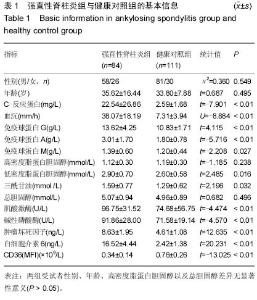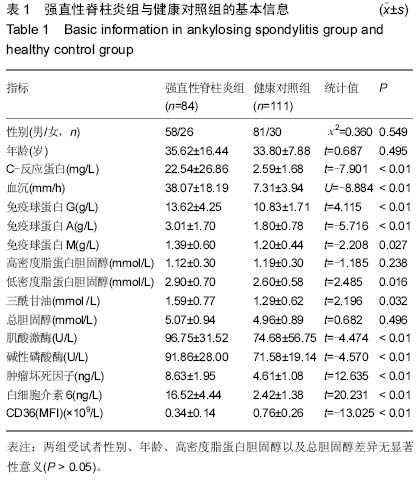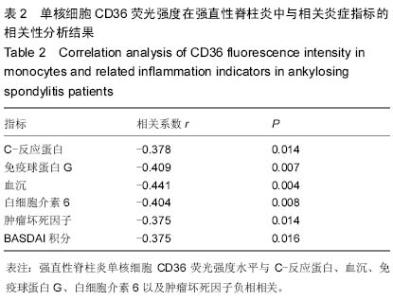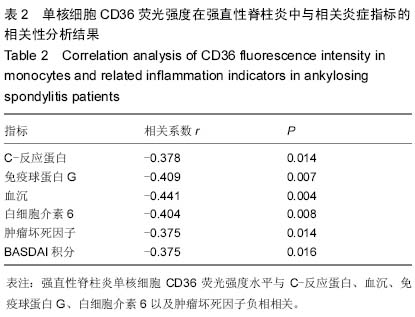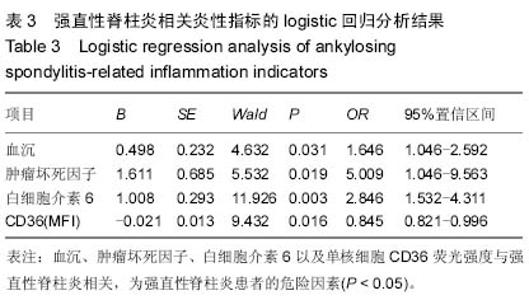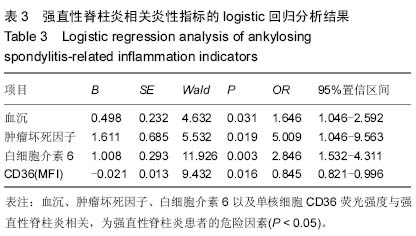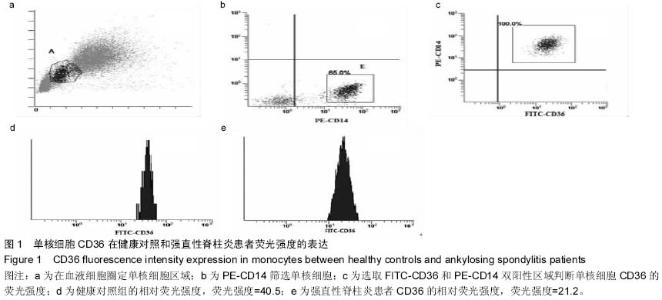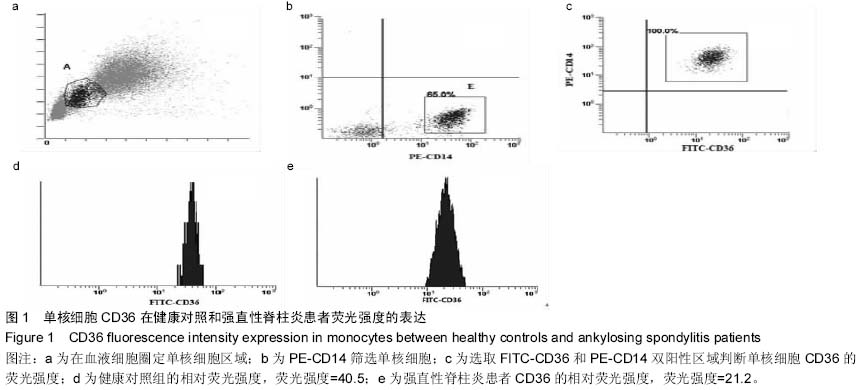Chinese Journal of Tissue Engineering Research ›› 2015, Vol. 19 ›› Issue (29): 4695-4699.doi: 10.3969/j.issn.2095-4344.2015.29.020
Previous Articles Next Articles
CD36 expression in monocytes and ankylosing spondylitis
Qin Wei, Lian Kai, Guo Qing
- Xiangyang Central Hospital/the Affiliated Hospital of Hubei University of Arts and Science, Xiangyang 441021, Hubei Province, China
-
Online:2015-07-09Published:2015-07-09 -
Contact:Guo Qing, Master, Nurse-in-charge, Xiangyang Central Hospital/the Affiliated Hospital of Hubei University of Arts and Science, Xiangyang 441021, Hubei Province, China -
About author:Qin Wei, Attending physician, Xiangyang Central Hospital/the Affiliated Hospital of Hubei University of Arts and Science, Xiangyang 441021, Hubei Province, China -
Supported by:the Natural Science Foundation of Hubei Province, No. 2011CDB318
CLC Number:
Cite this article
Qin Wei, Lian Kai, Guo Qing . CD36 expression in monocytes and ankylosing spondylitis [J]. Chinese Journal of Tissue Engineering Research, 2015, 19(29): 4695-4699.
share this article
| [1] El Maghraoui A.Extra-articular manifestations of ankylosing spondylitis: prevalence, characteristics and therapeutic implications.Eur J Intern Med. 2011;22(6):554-560 560. [2] Braun J, van den Berg R, Baraliakos X, et al.2010 update of the ASAS/EULAR recommendations for the management ofankylosing spondylitis. Annals of the Rheumatic Diseases. 2011;70(6):896-904 [3] Gonzalez-Juanatey C, Vazquez-Rodriguez TR, Miranda-Filloy JA, et al.The high prevalence of subclinical atherosclerosis in patients with ankylosing spondylitis without clinically evident cardiovascular disease.Medicine.2009;88(6)358-365. [4] Ge Y, Elghetany MT.CD36: a multiligand molecule. Lab Hematol.2005;11(1):31- 37. [5] Collot-Teixeira S, Martin J, McDermott-Roe C,et al. CD36 and macrophages in atherosclerosis. Cardiovasc Res.2007;75: 468-477. [6] Boyer JF, Balard P, Authier H, et al.Tumor necrosis factor alpha and adalimumab differentially regulate CD36 expression in human monocytes. Arthritis Res Ther.2007; 9(2):R22. [7] Wang C, Liao Q, Hu Y,et al.T lymphocyte subset imbalances in patients contribute to ankylosing spondylitis. Exp Ther Med. 2015;9(1):250-256. [8] 冯家烜,徐茂锦.CD36与糖尿病动脉粥样硬化关系的研究进展[J], 实用糖尿病杂志,2013,5(1):3-6. [9] Ramos-Arellano LE, Muñoz-Valle JF, De la Cruz-Mosso U, et al.Circulating CD36 and oxLDL levels are associated with cardiovascular risk factors in young subjects. BMC Cardiovasc Disord. 2014;14:54. [10] Kim EH, Tolhurst AT, Szeto HH, Cho SH.Targeting CD36-mediated inflammation reduces acute brain injury in transient, but not permanent, ischemic stroke.CNS Neurosci Ther.2015;21(4):385-391. [11] 杨敏,李林瑞,孟燕妮,等.凝血酶敏感蛋白-1及其受体CD36在支气管肺发育不良患儿中的表达及临床意义[J].中外医学研究, 2015,11(13):1-5. [12] 罗俊一,马依彤,谢翔,等.CD36基因多态性与急性冠脉综合征关联性的研究. 中华流行病学杂志2014, 2(35):200-204. [13] Peng YF, Cao L, Zeng YH, et al. Platelet to lymphocyte ratio and neutrophil to lymphocyte ratio in patients with rheumatoid arthritis. Open Med. 2015; 10: 249-253. [14] Peng YF, Zhang Q, Cao L, et al. Red blood cell distribution width: a potential marker estimating disease activity of ankylosing spondylitis. Int J Clin Exp Med. 2014;7(12):5289-5295. [15] Kawakami M,Murase T,Ogawa H,et al.Human recombinant TNF suppresses lipoprotein lipase activity and stimulates lipolysis in 3T3-l1 cells. J Biochem. 1987;101:331-338. [16] 申成凯,吕成昱,王英振,等.白细胞介素10启动子基因多态性与强直性脊柱炎的易感性[J].中国组织工程研究,2013,20(17): 3793-3799. [17] 彭隽,贾汝汉,党建中,等.CD36在高糖诱导的大鼠肾小球系膜细胞凋亡中的作用及机制[J].中华肾脏病杂志,2014,30(5):370-376. [18] Huang JT, Welch JS, Ricote M, et al.Interleukin-4-dependent production of PPAR-gamma ligands in macrophages by 12/15-lipoxygenase.Nature.1999; 400:378-382. [19] Draude G, Lorenz RL.TGF-beta1 downregulates CD36 and scavenger receptor A but upregulates LOX-1 in human macrophages.Am J Physiol Heart Circ Physiol. 2000;278: 1042-1048. [20] Rubic T, Lorenz RL.Downregulated CD36 and oxLDL uptake and stimulated ABCA1/G1 and cholesterol efflux as antiatherosclerotic mechanisms of interleukin-10. Cardiovasc Res.2006;69:527-535. [21] Suzawa M, Takada I, Yanagisawa J,et al.Cytokines suppress adipogenesis and PPAR-gamma function through the TAK1/TAB1/NIK cascade.Nat Cell Biol 2003;5:224-230. [22] Sung CK, She H, Xiong S,et al.Tumor necrosis factoralpha inhibits peroxisome proliferator-activated receptor gamma activity at a posttranslational level in hepatic stellate cells. Am J Physiol Gastrointest Liver Physiol. 2004;286:722-729. [23] Boyer JF, Balard P, Authier H,et al.“Tumor necrosis factor alpha and adalimumab diffrentially regulate CD36 expression in human monocytes,” ArthritisResearchandThrapy.2007; 99(2):22-25. [24] Peng YF, Zhang ZX, Cao W, et al.The association between red blood cell distribution width and acute pancreatitis associated lung injury in patients with acute pancreatitis. Open Med.2015; 10: 176-179. [25] Driscoll WS, Vaisar T, Tang J, et al.Raines.Macrophage ADAM17 defiiency augments CD36-dependent apoptotic cell uptake and the linked anti-inflmmatory phenotype,” Circulation Research.2013;113(1):52-61. [26] Asada K,Sasaki S,Suda T,et al.Antiinflammatory roles of peroxisome proliferator-activated receptor gamma in human alveolar macrophages. Am J Respir Crit Care Med.2004; 169:195-200. [27] Chung EY, Liu J, Homma Y, et al.Interleukin-10 expression in macrophages during phagocytosis of apoptotic cells is mediated by homeodomain proteins Pbx1 and Prep-1. Immunity.2007;27:952–964. [28] Bottcher A,Gaipl US,Furnrohr BG,et al.Involvement of phosphatidylserine,alphavbeta3, CD14, CD36, and complement C1q in the phagocytosis of primarynecrotic lymphocytes by macrophages.Arthritis Rheum.2006;54: 927-938. [29] Hu YF, Yeh HI, Tsao HM, et al..Impact of circulating monocyte CD36 level on atrial fibrillation and subsequent catheter ablation.Heart Rhythm.2011; 8(5):650-656. [30] Serghides L,Kain KC.Peroxisome proliferator-activated receptor gamma-retinoid X receptor agonists increase CD36-dependent phagocytosis of Plasmodium falciparum-parasitized erythrocytes and decrease malaria-induced TNF-alpha secretion by monocytes/ macrophages. Immunol.2001;166:6742-6748. [31] Boyer JF, Balard P, Authier H, et al. Tumor necrosis factor alpha and adalimumab differentially regulate CD36 expression in human monocytes. Arthritis Res Ther. 2007;9: 22. [32] Tontonoz P, Nagy L, Alvarez JG, et al. PPARgamma promotes monocyte/macrophage differentiation and uptake of oxidized LDL.Cell.1998;93:241-252. |
| [1] | Jiang Shengyuan, Li Dan, Jiang Jianhao, Shang-you Yang, Yang Shuye. Biological response of Co2+ to preosteoblasts during aseptic loosening of the prosthesis [J]. Chinese Journal of Tissue Engineering Research, 2021, 25(21): 3292-3299. |
| [2] | Yang Fan, Liu Baoyi, Cao Meng, Zhu Xiaoshu, Zhang Yu, Qin Kairong, Zhao Dewei. Basic fibroblast growth factors protect chondrocytes by antagonizing extracellular inflammatory factors [J]. Chinese Journal of Tissue Engineering Research, 2020, 24(23): 3621-3626. |
| [3] |
Li Qinxuan, Wang Yizhi, Xu Yan, Zhang Huayang, Lü Qixuan, Zhang Cheng, He Zhengyun, Zhang Xiao, Yang Zheng.
Effects of dexamethasone combined with estrogen on the
expression of interleukin-6, Caspase3 and Bcl-2 after spinal cord contusion in
rats |
| [4] | Li Peng, Yang Shuye, Zhang Kai, Jia Long, Du Gangqiang, Liu Dong, Zhang Xinjun, Zhang Degang, Wang Zhigang. Influence of different wear particles on human peripheral blood mononuclear cells in vitro [J]. Chinese Journal of Tissue Engineering Research, 2019, 23(6): 894-900. |
| [5] | Chen Peng, Shi Xiaotian, Guo Yu, Qiu Xunyong, Wang Yan. Longbie capsule combined with bone marrow mesenchymal stem cell transplantation for knee osteoarthritis [J]. Chinese Journal of Tissue Engineering Research, 2019, 23(5): 797-802. |
| [6] | Zhao Hongshun, A Jiancuo, Gao Shunhong, Li Yonggang, Guo Liping. Intraoperative and postoperative blood loss and levels of C-reactive protein and interleukin-6 after local application of tranexamic acid in total hip arthroplasty [J]. Chinese Journal of Tissue Engineering Research, 2019, 23(4): 493-498. |
| [7] | Wu Xingyuan, Zhang Guoru, Liu Tang, Zhou Caisheng. Intravenous and intraarticular tranexamic acid can reduce blood loss and inflammatory response during cemented posterior cruciate ligament-retaining unilateral total knee arthroplasty [J]. Chinese Journal of Tissue Engineering Research, 2019, 23(36): 5753-5759. |
| [8] | Meng Qingxi1, Wang Weiheng2, Sun Aijun3, Xi Yanhai1, Ye Xiaojian1. Protective effects of methane saturated saline on endotoxin-induced acute lung injury in rats [J]. Chinese Journal of Tissue Engineering Research, 2019, 23(3): 396-403. |
| [9] | Gao Hua1, 2, Li Yanxia1, Wang Dan1, Yang Xinling1 . Protective effects and the mechanism of lipoic acid on cell model of Parkinson’s disease induced by lipopolysaccharide [J]. Chinese Journal of Tissue Engineering Research, 2019, 23(3): 447-452. |
| [10] | Chen Jun1, Lin Jie2, Zhao Zhongsheng2, Huang Yanfeng2, Wu Guangwen3. Effect of Wutou Decoction on TLR4/NF-κB signaling pathway in synovial tissue of rat models with knee osteoarthritis [J]. Chinese Journal of Tissue Engineering Research, 2019, 23(27): 4381-4386. |
| [11] | Liang Weidong, Ren Zhouliang, Sheng Jun, Cao Rui, Sheng Weibin. Interleukin-1beta, interleukin-6 and tumor necrosis factor-alpha inhibit expression of type II collagen in nucleus pulposus cells [J]. Chinese Journal of Tissue Engineering Research, 2019, 23(21): 3410-3417. |
| [12] | Hu Xiaoli, Gu Ying, Cai Yan, Xie Jin, Liu Chan. Assessment of seven joint ultrasound score for early rheumatoid arthritis [J]. Chinese Journal of Tissue Engineering Research, 2019, 23(16): 2523-2528. |
| [13] | Tang Haifang1, 2, 3, 4, Peng Juanmin1, 2, 3, 4, Kang Na1, 2, 3, 4 . Relationship between p38 signaling pathway and periodontal ligament fibroblasts secreting inflammatory factors under static pressure [J]. Chinese Journal of Tissue Engineering Research, 2019, 23(15): 2308-2313. |
| [14] | Bai Sheng-chao1, Chen Sheng-ju1, Wang Bo1, Wu Ying1, Shang Hua-yu2. Effect of acupuncture on the expression level of interleukin-6 in rats after a single eccentric exercise [J]. Chinese Journal of Tissue Engineering Research, 2018, 22(32): 5191-5196. |
| [15] | Jin Na, Yao Xing-yu, Zhang Guo-hua, Yang Li-min, Li Jian-bo, Liu Jie, Wei Lin-huan, Duan Rui. Intravenous transplantation of human umbilical cord blood mononuclear cells in an intracerebral hemorrhage rat model: microPET-CT evaluation and anti-inflammatory mechanisms [J]. Chinese Journal of Tissue Engineering Research, 2018, 22(25): 4014-4020. |
| Viewed | ||||||
|
Full text |
|
|||||
|
Abstract |
|
|||||
